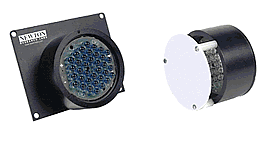|
Choose
the right tool for the right job. Listed below are brief descriptions
of the most common types of lighting.
Back
lighting: Commonly used for finding holes and taking
dimensional measurements of objects (webs). Bright back lighting
can penetrate opaque webs thus highlighting specs and blemishes
within the web as dark spots.
Front lighting: Commonly used
for applications where features on the surface of the object
(web) are to be inspected. It is a simple concept where the
lights illuminate the object from the front. Typically the
lights are angled at 45 degrees shining down from the side
with the camera looking straight down at the object. This
technique is best used on surfaces that are not too reflective.
Diffuse Lighting: Commonly used
for inspecting very reflective and curved surfaces and for
detecting the presence of features on polished components.
Polarizing filters also allow unwanted reflections to be dramatically
reduced in intensity.
Structured Light: Commonly used
to illuminate objects in order to extract depth information
where other methods are impractical. Typically this involves
a laser light source emitting a line or lines of light which,
when projected on the three dimensional part, leaves a profile
of it from which to gain data.
Ring Lighting: Commonly used
when inspecting circular objects, small objects, or small
areas of large objects. This technique provides very even
illumination around the object.
|

|
GENERAL
LIGHTING CONSIDERATIONS
In
general there are four main considerations when choosing
a light source which will result in more consistent
inspection results:
AMBIENT
LIGHT
PART
PRESENTATION
CHOOSING
THE APPROPRIATE LIGHT SOURCE
BUDGET
Please
contact Newton Labs for your
local Authorized Distributor.
|
Fiber
Optic Lighting: Commonly used for small space constraint
and small object illumination.
Low Angle Lighting: Commonly
used for highlighting small surface features and textures
where the features will appear bright against a dark background.
In this technique, the light source shines from the side at
a very low angle where the light glances off the object. It
is important in this scenario to maintain a constant angle
from light source to object for consistent and accurate results.
|






